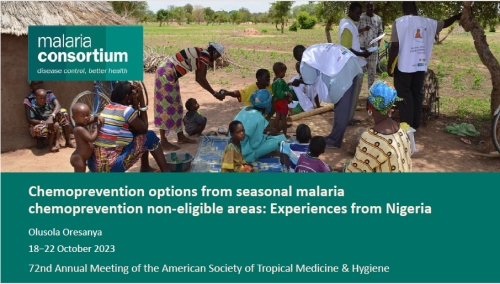
Publication Date:
21/10/2023
Author:
Olusola Oresanya
Type:
Presentation

Chemoprevention options from seasonal malaria chemoprevention non-eligible areas: Experiences from Nigeria
Publication Date:21/10/2023
Author:
Olusola Oresanya
Type:
Presentation
Following the development of a malaria stratification map for Nigeria, a study is being carried out to assess the impact and operational feasibility of perennial malaria chemoprevention in Osun state.
In 2019, Nigeria responded to the global call to get the high burden to high impact (HBHI) countries back on track to achieve the 2025 Global Technical Strategy milestones. Context-specific analyses were conducted to identify appropriate intervention-mixes for the different epidemiological settings in the country to aid prioritisation and achieve impact. A combination of indicators was used to develop a malaria stratification map.
A mix of malaria interventions were identified for different epidemiological strata in Nigeria, including chemoprevention targeting children and pregnant women. There are three chemopreventive therapies identified in the malaria stratification map, including intermittent preventive treatment during pregnancy (IPTp), seasonal malaria chemoprevention (SMC) and perennial malaria chemoprevention (PMC).
A study is being carried out in Osun state in the southwest of Nigeria to provide evidence on the impact of PMC on malaria burden and related clinical outcomes and its operational feasibility. The objectives of the study are:
- To evaluate the impact of PMC in children 2–18 months on key child health outcomes including malaria cases, hospitalisation and anaemia outcomes.
- To describe indicators of operational feasibility of PMC by identifying and measuring key determinants of successful uptake and implementation of PMC in Nigeria.
This presentation was given at the 72nd annual meeting of the American Society of Tropical Medicine and Hygiene.
Country: Nigeria
Keywords: Chemoprevention | Malaria | PMC | SDGs
« Back to Publications